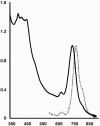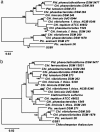An obligately photosynthetic bacterial anaerobe from a deep-sea hydrothermal vent
- PMID: 15967984
- PMCID: PMC1166624
- DOI: 10.1073/pnas.0503674102
An obligately photosynthetic bacterial anaerobe from a deep-sea hydrothermal vent
Abstract
The abundance of life on Earth is almost entirely due to biological photosynthesis, which depends on light energy. The source of light in natural habitats has heretofore been thought to be the sun, thus restricting photosynthesis to solar photic environments on the surface of the Earth. If photosynthesis could take place in geothermally illuminated environments, it would increase the diversity of photosynthetic habitats both on Earth and on other worlds that have been proposed to possibly harbor life. Green sulfur bacteria are anaerobes that require light for growth by the oxidation of sulfur compounds to reduce CO2 to organic carbon, and are capable of photosynthetic growth at extremely low light intensities. We describe the isolation and cultivation of a previously unknown green sulfur bacterial species from a deep-sea hydrothermal vent, where the only source of light is geothermal radiation that includes wavelengths absorbed by photosynthetic pigments of this organism.
Figures




Similar articles
-
Physiology and phylogeny of green sulfur bacteria forming a monospecific phototrophic assemblage at a depth of 100 meters in the Black Sea.Appl Environ Microbiol. 2005 Dec;71(12):8049-60. doi: 10.1128/AEM.71.12.8049-8060.2005. Appl Environ Microbiol. 2005. PMID: 16332785 Free PMC article.
-
Geochemical constraints on chemolithoautotrophic metabolism by microorganisms in seafloor hydrothermal systems.Geochim Cosmochim Acta. 1997 Oct;61(20):4375-91. doi: 10.1016/s0016-7037(97)00241-x. Geochim Cosmochim Acta. 1997. PMID: 11541662
-
Large-scale distribution and activity patterns of an extremely low-light-adapted population of green sulfur bacteria in the Black Sea.Environ Microbiol. 2010 May;12(5):1348-62. doi: 10.1111/j.1462-2920.2010.02178.x. Epub 2010 Mar 9. Environ Microbiol. 2010. PMID: 20236170
-
Effects of shallow-water hydrothermal venting on biological communities of coastal marine ecosystems of the western Pacific.Adv Mar Biol. 2006;50:267-421. doi: 10.1016/S0065-2881(05)50004-X. Adv Mar Biol. 2006. PMID: 16782453 Review.
-
Effects of solar UV-B radiation on aquatic ecosystems.Adv Space Res. 2000;26(12):2029-40. doi: 10.1016/s0273-1177(00)00170-8. Adv Space Res. 2000. PMID: 12038489 Review.
Cited by
-
Hydrogen-deuterium exchange mass spectrometry reveals the interaction of Fenna-Matthews-Olson protein and chlorosome CsmA protein.Biochemistry. 2012 Jan 10;51(1):187-93. doi: 10.1021/bi201620y. Epub 2011 Dec 9. Biochemistry. 2012. PMID: 22142245 Free PMC article.
-
A switchable self-assembling and disassembling chiral system based on a porphyrin-substituted phenylalanine-phenylalanine motif.Nat Commun. 2016 Sep 1;7:12657. doi: 10.1038/ncomms12657. Nat Commun. 2016. PMID: 27582363 Free PMC article.
-
Analysis of the metatranscriptome of microbial communities of an alkaline hot sulfur spring revealed different gene encoding pathway enzymes associated with energy metabolism.Extremophiles. 2016 Jul;20(4):525-36. doi: 10.1007/s00792-016-0846-6. Epub 2016 Jun 11. Extremophiles. 2016. PMID: 27290724
-
A model of the protein-pigment baseplate complex in chlorosomes of photosynthetic green bacteria.Photosynth Res. 2010 Jun;104(2-3):233-43. doi: 10.1007/s11120-009-9519-y. Epub 2010 Jan 14. Photosynth Res. 2010. PMID: 20077007 Review.
-
Subfossil 16S rRNA gene sequences of green sulfur bacteria in the Black Sea and their implications for past photic zone anoxia.Appl Environ Microbiol. 2008 Feb;74(3):624-32. doi: 10.1128/AEM.02137-07. Epub 2007 Nov 26. Appl Environ Microbiol. 2008. PMID: 18039829 Free PMC article.
References
-
- Blankenship, R. E. (2002) Molecular Mechanisms of Photosynthesis (Blackwell Science, Oxford).
-
- Van Dover, C. L. (2000) The Ecology of Deep-Sea Hydrothermal Vents (Princeton Univ. Press, Princeton).
-
- Van Dover, C. L., Reynolds, G. T., Chave, A. D. & Tyson, J. A. (1996) Geophys. Res. Lett. 23, 2049-2052.
-
- Nisbet, E. G., Cann, J. R. & VanDover, C. L. (1995) Nature (London) 373, 479-480.
Publication types
MeSH terms
Substances
Associated data
- Actions
- Actions
- Actions
- Actions
- Actions
- Actions
- Actions
- Actions
- Actions
- Actions
- Actions
- Actions
- Actions
- Actions
- Actions
- Actions
- Actions
- Actions
- Actions
- Actions
- Actions
- Actions
- Actions
- Actions
- Actions
- Actions
- Actions
- Actions
- Actions
- Actions
- Actions
- Actions
- Actions
- Actions
- Actions
- Actions
- Actions
- Actions
- Actions
- Actions
- Actions
- Actions
- Actions
- Actions
- Actions
- Actions
- Actions
- Actions
- Actions
- Actions
- Actions
- Actions
- Actions
- Actions
- Actions
- Actions
- Actions
- Actions
- Actions
- Actions
- Actions
- Actions
- Actions
- Actions
- Actions
- Actions
- Actions
- Actions
- Actions
- Actions
- Actions
- Actions
- Actions
LinkOut - more resources
Full Text Sources
Other Literature Sources
Molecular Biology Databases

